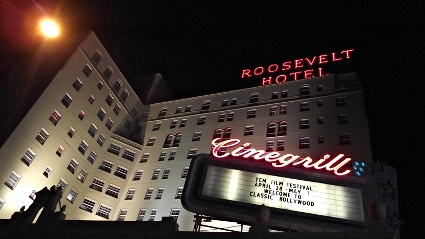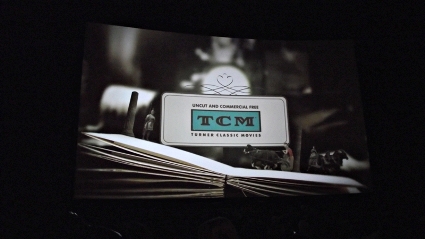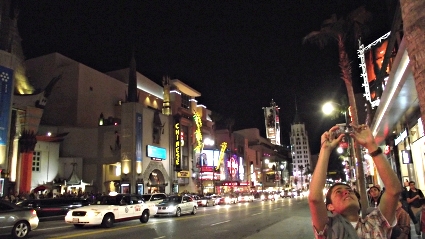And all that’s MOVing
13/05/2011
This is already the second edition of the TCM Classic Film Festival. Cinema, the national art of Americans, has finally got its exclusive festival. The profile of this event shows how important this channel is in the film market: it acts as a watchman of tradition, reminding us of the old works of the cinematographic art.
Five days spent in Hollywood, Los Angeles, were an explosive mixture of elation and encounters with kitsch.  The festival took place on the Hollywood Boulevard. Passing one gold star after another, one could get numerous souvenirs and gadgets; they were all, however, of low quality and unable to reflect the magic of that place. The films were played on five screens in three cinemas, and the centre of things was in the TCM Club at the Roosevelt Hotel, one of the most famous American hotels. That is where in 1929 the Film Academy delivered its verdict for the first time (it took 15 minutes), and some say that the hotel mirror is haunted by Marilyn Monroe.
The festival took place on the Hollywood Boulevard. Passing one gold star after another, one could get numerous souvenirs and gadgets; they were all, however, of low quality and unable to reflect the magic of that place. The films were played on five screens in three cinemas, and the centre of things was in the TCM Club at the Roosevelt Hotel, one of the most famous American hotels. That is where in 1929 the Film Academy delivered its verdict for the first time (it took 15 minutes), and some say that the hotel mirror is haunted by Marilyn Monroe.
The screenings took place in historic cinemas. They were built in the 20s on the wave of prosperity in the American film industry and the need to create high standard rooms; expensive and imitating elegant theatres. 1100 viewers can sit in front of the giant screen of the Chinese Theatre, the Egyptian Theatre holds over 600. The TCM Festival, held in historic places which we know from postcards and old albums, revives the idea of watching classic films on a large screen (nearly 80 screenings in three days!) with hundreds of viewers sitting in one room.
Apart from the choice of unique “places of action,” the exclusive character of the festival was also visible in the American gadget-mania, famous since the times of Star Wars (over 30 years ago). A recognised graphic artist Michael Schwab designed the visual aspects of the event: silhouettes of film characters drawn with a distinct contour line and filled with black, against a solid colour background. They became the basis for countless variations: the graphics of Schwab were seen on festival bandannas, flashlights, fridge magnets, water bottles, bags, mugs, T-shirts, collectors’ postcards, posters, specially stylised film reels etc. You could buy 4 kinds of tickets: the most expensive ones included walking the red carpet to the opening of the festival, which was the screening of a remastered version of An American in Paris, and participating in elite parties which concluded each day of the festival.
The organisation of the Classic Film Festival was excellent and virtually unnoticeable. The films started at precisely established times. The schedule assumed simultaneous screenings of several films and discussion panels with the invited guests. Brett Ratner, creator of the Rush Hours trilogy, talked about the art of the sequel, and Debbie Reynolds, the unforgettable actress playing the main female role in Singin’ in the Rain, had a long talk with the fans and recalled the old days of working in Hollywood. Also, there was the Footprint Ceremony of Peter O’Toole during the festival, and Kirk Douglas took part in the digital screening of Kubrick’s Spartacus and a talk after the film.
The enormous archives of TCM and film institutes have been combed in serach of little gems.  Among nearly one hundred films, including shorts, only six were made after 1969, which is after the fall of classic Hollywood. The oldest ones, from 1922, were animated black-and-white Disney cartoons, made before he came to the Dream Factory. The great majority of the works were feature films made in the years between 1930 and 1965.
Among nearly one hundred films, including shorts, only six were made after 1969, which is after the fall of classic Hollywood. The oldest ones, from 1922, were animated black-and-white Disney cartoons, made before he came to the Dream Factory. The great majority of the works were feature films made in the years between 1930 and 1965.
During one of the screenings, The 7th Voyage of Sinbad (1958) was presented. The film has recently been placed in the National Film Registry – an institution which gathers cultural assets that build up the identity of the United States. This technicolor fairy tale, reviving the Arabian fantasy genre, is a display of Ray Harryhausen’s and Bernard Herrmann’s artistry. The latter is the legendary movie soundtrack composer to whom a special section of the festival was dedicated: creator of music to the best of Hitchcock’s films, Martin Scorsese’s Taxi Driver, writing music that is individual in its character, standing out from the homogeneous Hollywood mass production. Herrmann’s dramatically complex score corresponds with the visionary imagination of Harryhausen: creator of special effects, one of the patrons of the New Hollywood. Stop-motion animation of cyclops and, most importantly, the famous fight scene between Sinbad and the skeleton makes a great impression even today. No wonder that it made young Spielberg blush with excitement.
The „Discoveries” section seemed to be the most valuable. It was a selection of films that, according th the organisers, have not yet been properly appreciated by the audience. One of the films from this group, Design for Living, is an excellent comedy by Ernst Lubitsch from the early days of his sound work. Even today this morally bold ménage à trois story wins us with its graceful direction, distinct character creations (Gary Cooper) and dialogues reminiscent of screwball comedy (the author of which is the scriptwriter of Some Like It Hot, Ben Hecht).
I must admit that the quality of the screenings was the festival’s biggest asset. In Hollywood I was lucky to see cinema’s biggest masterpiece, which is Orson Welles’ Citizen Kane. The digital premiere of the remastered version, I can only call, for lack of a better expression, mind-blowing. The big screen dispels all doubts: this film has not aged one bit. During the screening, the viewer does not at all need to turn a blind eye to the naivety of the storyline or the production. The momentum of the vision, freshness of the cinematic means, and absolute perfection of each frame is striking. During this festival you will not hear the crackling of film tape or see any grainy takes. Americans spend huge amounts of money on saving their cinematic heritage. Reconstruction work in Poland is still not a priority. The Film Foundation, managed by such big names as Scorsese, Coppola and Eastwood, is making sure that the magic of films will never fade. The institution has already restored several hundreds of titles. Apart from this institution there are many others which deal with restoring motion pictures. During the second edition, like last year, one could see a multitude of classic films in the highest visual quality. The premiere of a remastered Who’s Afraid of Virginia Woolf (1966) was honoured by the cameraman of this film, double Oscar award winner Haskell Wexler, who filmed the whole event… using a mobile phone.
During this festival you will not hear the crackling of film tape or see any grainy takes. Americans spend huge amounts of money on saving their cinematic heritage. Reconstruction work in Poland is still not a priority. The Film Foundation, managed by such big names as Scorsese, Coppola and Eastwood, is making sure that the magic of films will never fade. The institution has already restored several hundreds of titles. Apart from this institution there are many others which deal with restoring motion pictures. During the second edition, like last year, one could see a multitude of classic films in the highest visual quality. The premiere of a remastered Who’s Afraid of Virginia Woolf (1966) was honoured by the cameraman of this film, double Oscar award winner Haskell Wexler, who filmed the whole event… using a mobile phone.
To conclude I would like to mention the only screenings of feature-length films from the 20s. TCM had chosen two masterpieces of late silent cinema. The Merry Widow by Erich von Stroheim makes use of The Merry Widow libretto to create a love story which has a strong emotional impact. It is set in a fictional state which reminds the Austro-Hungarian Empire at its end. Dutch composer Maud Nelissen, who specialises in creating music for silent films, did an excellent job. By combining motifs from Lehar’s operetta with her own material, she broke with the schemes of silent cinema’s musical illustrations. The timbre of particular instruments was much more important than the leitmotifs. Exact ilustrativeness has been replaced with a discreet play with silence, played by an orchestra with an extended array of percussion instruments. Vince Giordano & Nighthawks Orchestra has moved the audience into a different poetics. Giordano is a musician and an archivist who gathers materials concerning jazz and popular music in the 20s and 30s, and who plays in New York clubs on a regular basis. He compiled the musical score to Buster Keaton’s The Cameraman – the best film that I had a chance to see during the festival. The story, one of a beginner film reporter from New York, shown on the big screen makes a huge impression thanks to the multitude of gags and the perfection of technical tricks. The brass band, accompanied by drums, solo violin and bass, directed by Giordano, created a unique atmosphere of the jazz age.
Vince Giordano & Nighthawks Orchestra has moved the audience into a different poetics. Giordano is a musician and an archivist who gathers materials concerning jazz and popular music in the 20s and 30s, and who plays in New York clubs on a regular basis. He compiled the musical score to Buster Keaton’s The Cameraman – the best film that I had a chance to see during the festival. The story, one of a beginner film reporter from New York, shown on the big screen makes a huge impression thanks to the multitude of gags and the perfection of technical tricks. The brass band, accompanied by drums, solo violin and bass, directed by Giordano, created a unique atmosphere of the jazz age.
The stay in Los Angeles gave me the opportunity to revise the myth of Polański’s „Chinatown.” How is the City of Angels doing today? The Chinese district is neat, sunny and idyllic, they serve cheap and excellent food there. L.A. River, to which Jack Nicholson went down to solve the mystery, is just as dry and blank today.
Sebastian Smoliński
TCM Classic Film Festival 2011: Hollywood, 28th of April – 1st of May
www.tcm.com/festival








.jpg)